
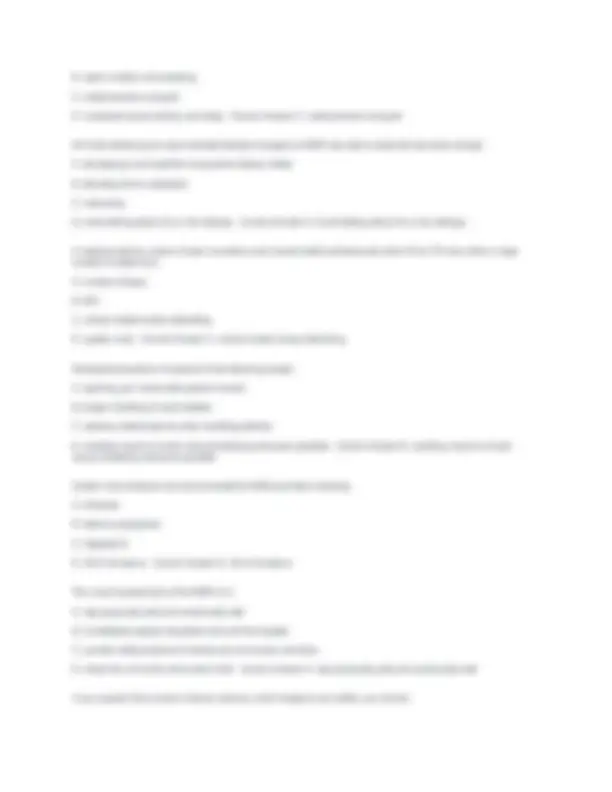
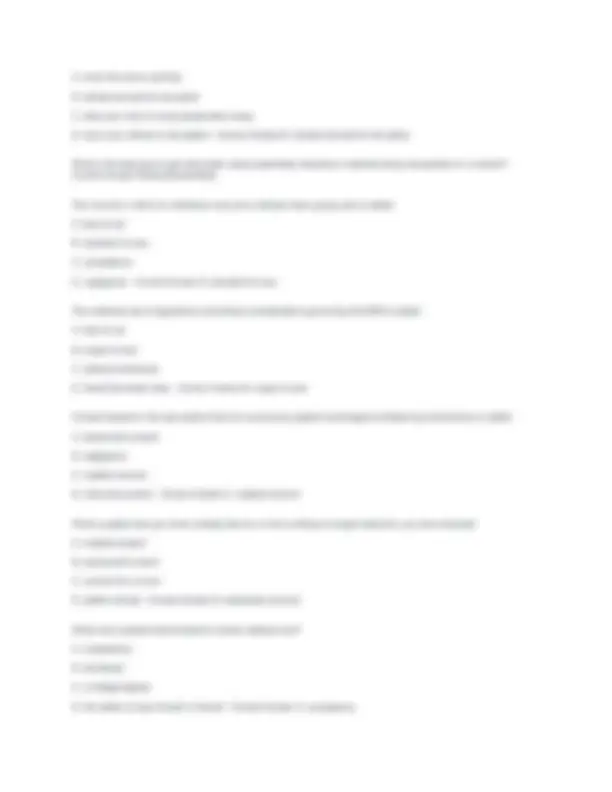
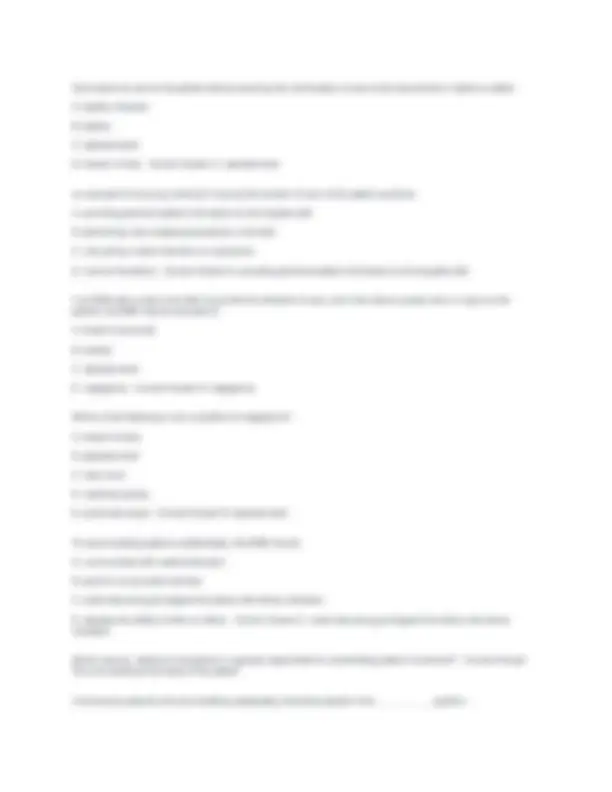
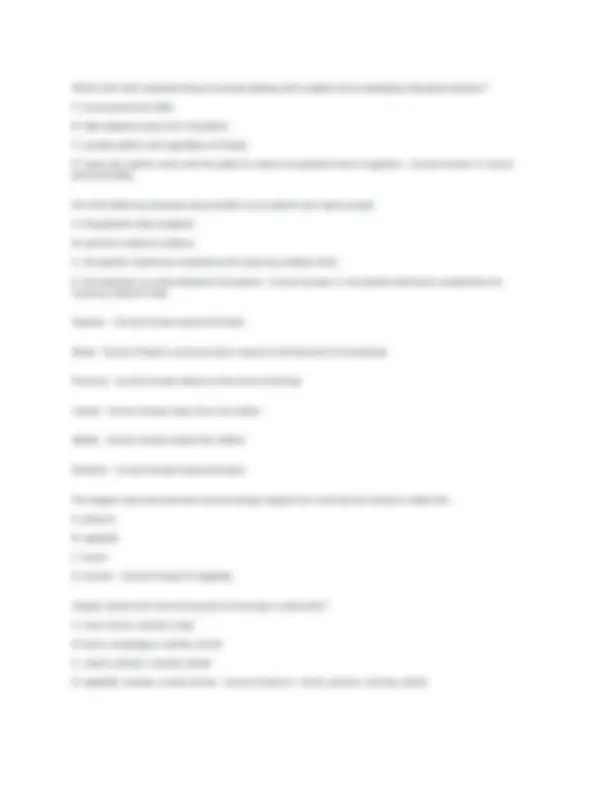
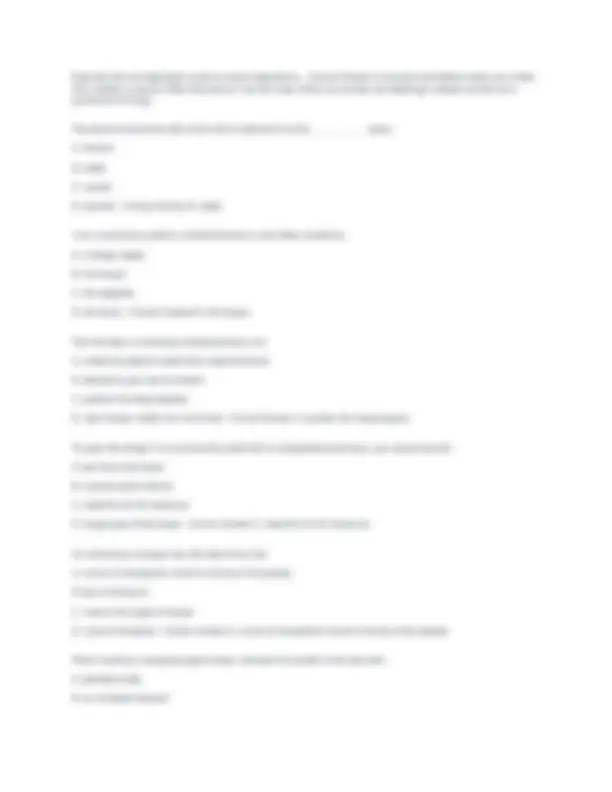
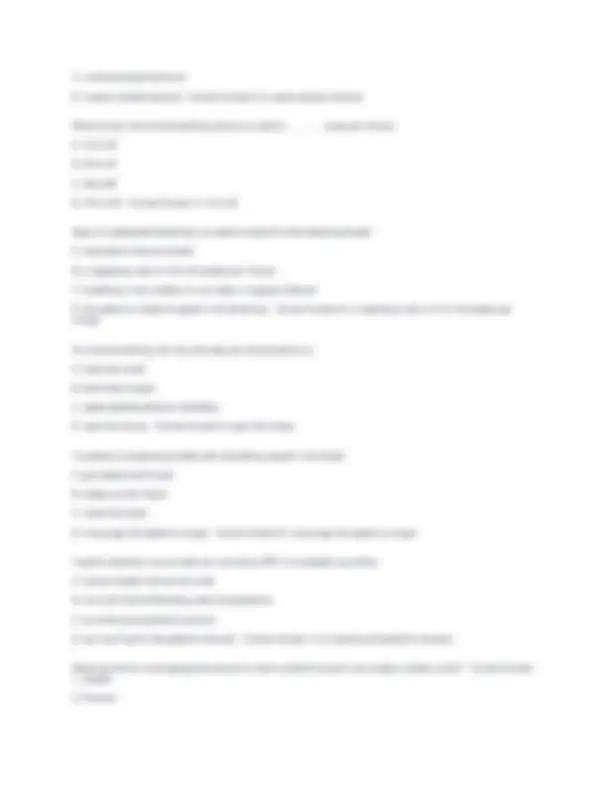
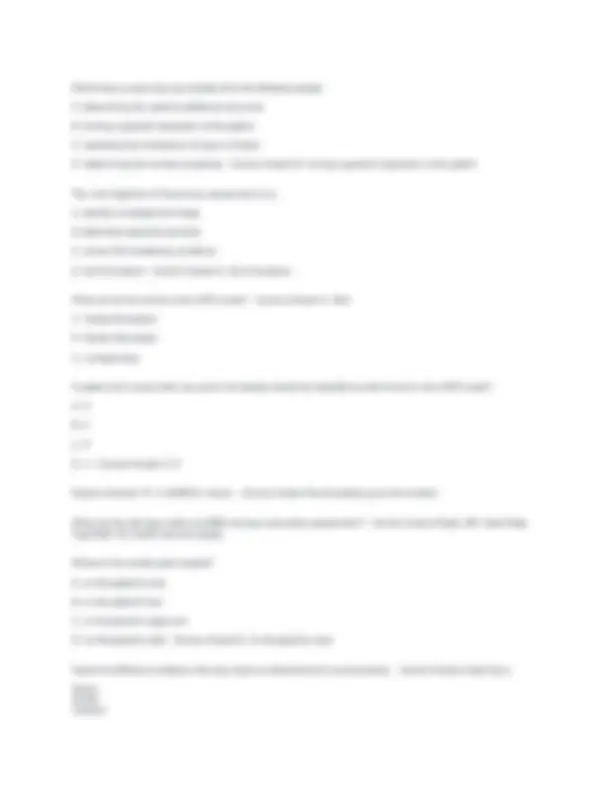
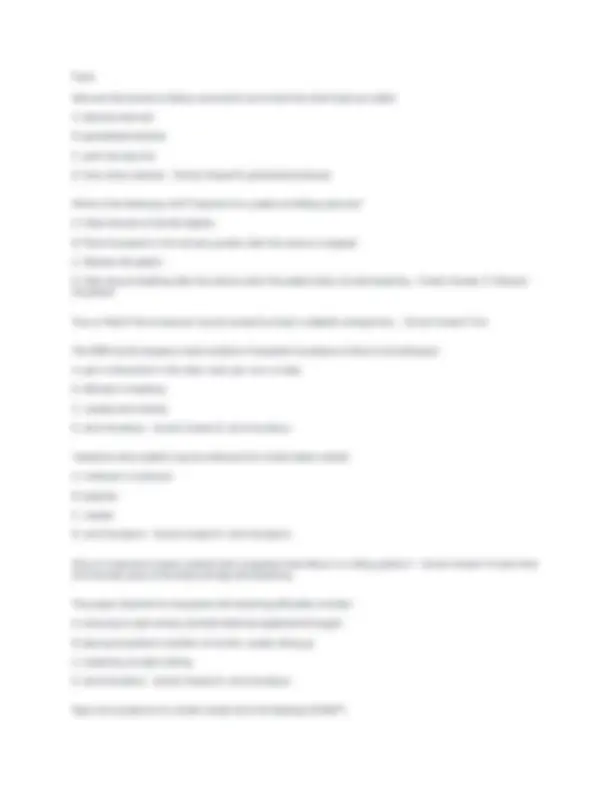
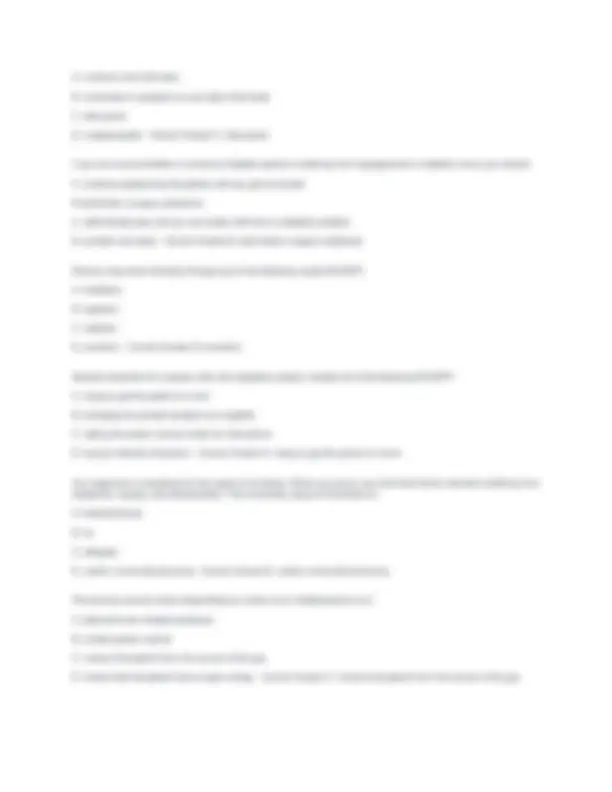


Study with the several resources on Docsity

Earn points by helping other students or get them with a premium plan


Prepare for your exams
Study with the several resources on Docsity

Earn points to download
Earn points by helping other students or get them with a premium plan
Community
Ask the community for help and clear up your study doubts
Discover the best universities in your country according to Docsity users
Free resources
Download our free guides on studying techniques, anxiety management strategies, and thesis advice from Docsity tutors
A set of multiple-choice questions and answers related to the emergency medical responder (emr) curriculum. It covers various aspects of emr training, including the role of the emr, emergency response procedures, patient assessment and care, stress management, standard precautions, patient movement techniques, and ethical considerations. Designed to help students prepare for their emr written exam.
Typology: Exams
1 / 15

This page cannot be seen from the preview
Don't miss anything!










EMRs are a critical component of an EMS system because they are
A. Responsible for reporting such emergencies
B. The first medically trained personnel to arrive on the scene
C. Able to provide both basic and advanced life support
D. Trained in traffic control - Correct Answer B. The first medically trained personnel to arrive on scene
Arrange the following events in order in which they occur in an emergency.
EMS Response
Hospital Care
Dispatch Reporting First Response - Correct Answer 1. Reporting
What is the key feature of an enhanced 911 call center? - Correct Answer Know what address the number is calling from
Which of the following is not a level of care typically found during the EMS response phase?
A.EMT B. AEMT
C. Paramedic
D. Physician - Correct Answer D. physician
The civilian EMS system tends to follow trends seen in which area of medicine?
A. Military Medicine
B. Hospital Medicine
C. Veterinary Medicine
D. Private Physician Medicine - Correct Answer Military medicine
National levels of EMS training include all of the following except:
A. Advanced First Aid
B. EMR
C. AEMT
D. Paramedic - Correct Answer A. Advanced First Aid
The major emphasis of the EMR curriculum deals with ___________ of the ill or injured patient in the prehospital setting.
A. Advanced Life Support
B. Interpretation of Electrocardiograms
C. Assessment and Care
D. Techniques of Advanced Airway Care - Correct Answer C. Assessment and Care
What is the best way to gain the confidence of both your patient and bystanders? - Correct Answer Take control of the scene and be professional.
True or False? The overall leader of the EMS system is the physician. - Correct Answer True
The difference between online (direct) and off-line (indirect) medical direction is that:
A. off-line medical direction does not need protocols
B. off-line orders are given by the on-duty physicians, usually over the radio or phone.
C. online medical directions uses standing orders
D. online orders are given by the on-duty physician, usually over the radio or phone` - Correct Answer D. online orders are given by the on-duty physician, usually over the radio or phone
Place the five stages of the normal reactions to stress in the order in which they usually occur.
Bargaining Anger Depression Denial Acceptance - Correct Answer 1. Denial
Some warning signs that an EMR is being affected by stress include.
A. overreacting and ringing in the ears
A. enter the scene carefully
B. retreat and wait for the police
C. blow your siren to scare perpetrators away
D. focus your efforts on the patient - Correct Answer B. retreat and wait for the police
What is the best way to get information about potentially hazardous materials being transported on a vehicle? - Correct Answer Placard/Guide Book
The manner in which an individual must act or behave when giving care is called:
A. duty to act
B. standard of care
C. competency
D. negligence - Correct Answer B. standard of care
The collective set of regulations and ethical considerations governing the EMR is called:
A. duty to act
B. scope of care
C. advance directives
D. Good Samaritan laws - Correct Answer B. scope of care
Consent based on the assumption that an unconscious patient would approve lifesaving interventions is called:
A. expressed consent
B. negligence
C. implied consent
D. informed consent - Correct Answer C. implied consent
When a patient lets you know verbally that he or she is willing to accept treatment, you have received:
A. implied consent
B. expressed consent
C. consent for a minor
D. patient refusal - Correct Answer B. expressed consent
What must a patient demonstrate to refuse medical care?
A. competency
B. disinterest
C. a college degree
D. the ability to treat himself or herself - Correct Answer A. competency
Termination of care of the patient without ensuring the continuation of care at the same level or higher is called:
A. liability infraction
B. battery
C. abandonment
D. breach of duty - Correct Answer C. abandonment
an example of ensuring continuity in during the transfer of care of the patient would be:
A. providing pertinent patient information to the hospital staff
B. performing more hospital procedures in the field.
C. only giving a report direction to a physician.
D. none of the above - Correct Answer A. providing pertinent patient information to the hospital staff
If an EMR with a duty to act fails to provide the standard of care, and if this failure causes harm or injury to the patient, the EMR may be accused of:
A. breach of promise
B. assault
C. abandonment
D. negligence - Correct Answer D. negligence
Which of the following is not a condition of negligence?
A. breach of duty
B. abandonment
C. duty to act
D. resulting injuries
E. proximate cause - Correct Answer B. abandonment
To avoid violating patient confidentiality, the EMR should:
A. communicate with medical direction
B. perform an accurate interview
C. avoid discussing privileged information with family members.
D. develop the ability to listen to others - Correct Answer C. avoid discussing privileged information with family members
Which rescuer, relative to the patient, is typically responsible for coordinating patient movement? - Correct Answer The one located at the head of the patient
Unconscious patients who are breathing adequately should be placed in the ___________ position.
A. a paging system
B. a mobile data terminal
C. a fax machine
D. telemetry - Correct Answer D. telemetry
Put these phases of the EMS call in the appropriate order.
Arrival on Scene
Transferring the care of the patient to other personnel
Response to the scene
Update responding EMS units
Postrun activities
Dispatch - Correct Answer 1. Dispatch
If you are not sure that you have received all the dispatch information correctly, ask the dispatcher to:
A. speak louder
B. write it down
C. repeat it
D. call back later - Correct Answer C. repeat it
Which information should NOT be relayed when transferring care of a patient to other professionals?
A. description of the history of the incident
B. description of the patient's chief complaint
C. your personal feelings about the patient's activities prior to the incident
D. description of the patient's level of responsiveness - Correct Answer C. your personal feelings about the patient's activities prior to the incident
After pressing the push-to-talk button on the radio, why should you wait for 1 second before starting your message? - Correct Answer to ensure dispatch gets your full radio transmission
Elderly patients often experience _________ hearing and visual activity - Correct Answer impaired
What are some techniques you can use to communicate effectively with pediatric patients? - Correct Answer pointing, tell them everything you're doing, smile, stay calm
What is the most important thing to do when dealing with a patient who is displaying disruptive behavior?
A. ensure personal safety
B. take weapons away from the patient
C. provide patient care regardless of threats
D. leave your partner alone with the patient to reduce the patient's level of agitation - Correct Answer A. ensure personal safety
All of the following should be documented in your patient care report except:
A. the patient's chief complaint
B. pertinent medical conditions
C. the specific treatments rendered by the receiving medical crews
D. the treatment you administered to the patient - Correct Answer C. the specific treatments rendered by the receiving medical crews
Superior - Correct Answer toward the head
Distal - Correct Answer a structure that is nearer to the free end of an extremity
Proximal - Correct Answer Nearer to the trunk of the body
Lateral - Correct Answer away from the midline
Medial - Correct Answer toward the midline
Posterior - Correct Answer toward the back
The flapper valve that prevents food and foreign objects from entering the trachea is called the:
A. pharynx
B. epiglottis
C. larynx
D. bronchi - Correct Answer B. epiglottis
Oxygen travels from the environment to the lungs in what order?
A. nose, larynx, trachea, lungs
B. larynx, esophagus, trachea, alveoli
C. mouth, pharynx, trachea, alveoli
D. epiglottis, trachea, cricoid, alveoli - Correct Answer C. mouth, pharynx, trachea, alveoli
C. a silicone-based lubricant
D. a water-soluble lubricant - Correct Answer D. a water-soluble lubricant
When at rest, the normal breathing rate for an adult is _______ times per minute:
A. 12 to 20
B. 30 to 40
C. 60 to 80
D. 75 to 100 - Correct Answer A. 12 to 20
Signs of inadequate breathing in an adult include all of the following except:
A. respirations that are slowed
B. a respiratory rate of 14 to 18 breaths per minute
C. breathing is very shallow, is very deep, or appears labored
D. the patient is unable to speak in full sentences - Correct Answer B. a respiratory rate of 14 to 18 breaths per minute
To correct breathing, the very first step you should take is to:
A. clear the mouth
B. administer oxygen
C. apply positive-pressure ventilation
D. open the airway - Correct Answer D. open the airway
If a patient is coughing forcefully with something caught in the throat:
A. give abdominal thrusts
B. sweep out the mouth
C. check the pulse
D. encourage the patient to cough - Correct Answer D. encourage the patient to cough
If gastric distention occurs while you are doing CPR, it is probably caused by:
A. rescue breaths that are too small
B. too much force while doing chest compressions
C. air entering the patient's stomach
D. too much fluid in the patient's stomach - Correct Answer C. air entering the patient's stomach
What are the four most appropriate places to check a patient's pulse if you suspect cardiac arrest? - Correct Answer
Which condition should exist before starting CPR?
A. dilated pupils
B. pale skin
C. shallow breathing
D. absence of breathing and pulse - Correct Answer D. absence of breathing and pulse
Place the following links in the Chain of Survival in the appropriate order:
Rapid Defibrillation
Immediate High Quality CPR
Basic and Advanced EMS
Recognition/Activation of EMS - Correct Answer 1. Recognition/Activation of EMS
If you are alone with a pulseless adult patient, you should:
A. perform CPR for 1 minute before activating the EMS system
B. activate the EMS system before beginning CPR
C. perform CPR for 3 minutes before activating the EMS system
D. perform CPR for 5 minutes before activating the EMS system - Correct Answer B. activate the EMS system before beginning CPR
Which of the following is NOT reliable sign of death:
A. decapitation
B. rigor mortis
C. dependent lividity
D. agonal gasps - Correct Answer D. agonal gasps
To perform chest compressions on an adult patient, you should press on the:
A. center of the patient's chest, on the lower half of the sternum
B. center of the patient's chest
C. xiphoid process
D. center of the patient's chest, on the upper half of the sternum - Correct Answer A. center of the patient's chest, on the lower half of the sternum
Performing a scene size-up includes all of the following except:
A. determining the need for additional resources
B. forming a general impression of the patient
C. assessing the mechanism of injury or illness
D. determining the number of patients - Correct Answer B. forming a general impression of the patient
The main objective of the primary assessment is to:
A. identify immediate life threats
B. determine treatment priorities
C. correct life-threatening conditions
D. all of the above - Correct Answer D. all of the above
What are the four levels of the AVPU scale? - Correct Answer A- Alert
V- Verbal Stimulation
P- Painful Stimulation
U- Unresponsive
A patient who moans when you pinch her earlobe should be classified as which level on the AVPU scale?
A. A
B. V
C. P
D. U - Correct Answer C. P
Explain what the "E" in SAMPLE means. - Correct Answer Events leading up to the incident
What are the vital signs taken by EMRs during a secondary assessment? - Correct Answer Pupils, BP, Heart Rate, Cap Refill, O2, breath rate and quality
Where is the carotid pulse located?
A. on the patient's wrist
B. on the patient's foot
C. on the patient's upper arm
D. on the patient's neck - Correct Answer D. on the patient's neck
Name five different conditions that may cause an altered level of consciousness. - Correct Answer Head injury
Shock Stroke Infection
Fever
Seizures that produce shaking movements and involve the entire body are called:
A. absence seizures
B. generalized seizures
C. perit mal seizures
D. tonic-clonic seizures - Correct Answer B. generalized seizures
Which of the following is NOT treatment for a patient exhibiting seizures?
A. Clear the area of harmful objects
B. Place the patient in the recovery position after the seizure is stopped.
C. Restrain the patient
D. Start rescue breathing after the seizure ends if the patient does not start breathing - Correct Answer C. Restrain the patient
True or False? Some seizures may be caused by stroke or diabetic emergencies. - Correct Answer True
The EMR should suspect a heart condition if the patient complains of which of the following?
A. pain or discomfort in the chest, neck, jaw, arm, or back
B. difficulty in breathing
C. nausea and vomiting
D. all of the above - Correct Answer D. all of the above
Indications that a patient may be suffering from a heart attack include:
A. chest pain or pressure
B. dyspnea
C. nausea
D. all of the above - Correct Answer D. all of the above
Why is it important to place a patient with congestive heart failure in a sitting position? - Correct Answer To drain fluid into the lower parts of the body and help with breathing.
The proper treatment for the patient with breathing difficulties includes:
A. ensuring an open airway and administering supplemental oxygen.
B. placing the patient in position of comfort, usually sitting up.
C. loosening any tight clothing
D. all of the above - Correct Answer D. all of the above
Signs and symptoms of a stroke include all of the following EXCEPT: